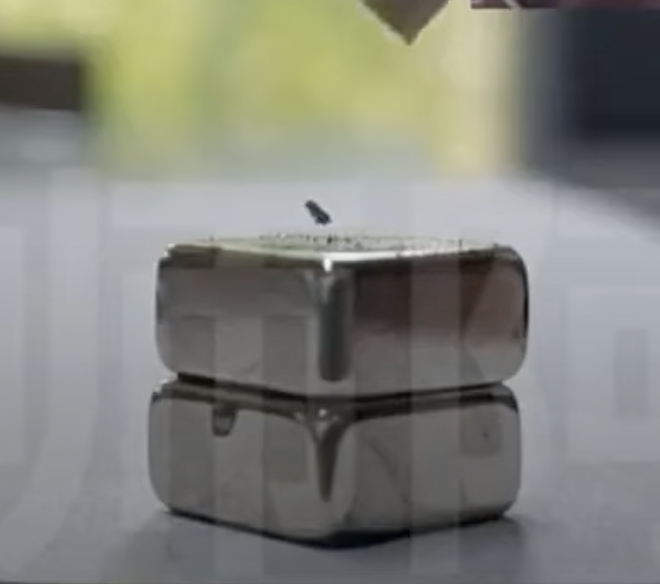31
Andrew Cote (@Andercot)
nitter.netLK-99: The Case for Skepticism
By now there's been a number of replications, videos, pre-prints on arxiv, and at-home or at-work attempts to reproduce the original findings of Lee and Kim.
Here's why I'm increasingly skeptical on LK-99 and my reasoning:
#1 - The Videos
There's been a number of videos produced and circulating the internet showing partial levitation or full levitation, the kind of thing you see in cryogenic superconductors that 'quantum lock' or 'flux pin' and float in mid-air.
The issue with all these videos is that the visual behavior is completely indistinguishable from a diamagnetic.
I was initially under the impression that you could not produce stable levitation from two simple dipoles, according to a time-honored theorem from physics by Earnshaw, and so levitation above a single magnet was 'proof positive'.
However, as it turns out, there is a less well-known exception to this rule called Brauenbecker extension which provides a mathematical proof that levitation is possible with a simple diamagnetic in a dipole field so long as the diamagnetic material mass is very small relative to the strength of the magnetic field.
(Note that there are plenty of videos of a diamagnetic floating above a grid of magnets, but those magnets have a more complicated field than a dipole and so Earnshaw's theorem does not apply. Here is the derivation of Brauenbecker's result for the curious: https://cds.cern.ch/record/535810/files/cm-p00038446.pdf )
The suspicious thing in the levitation of LK-99 videos is that the 'stable equilibrium point' is directly above the center of the magnet. This is what you'd expect via the Brauenbecker derivation - that the only stable point is in the center. A flux-pinned super conductor could levitate in many different orientations including off to the side of the magnet.
Conclusion - the videos do NOT show flux-pinning.
#2 The Simplest Measurements are Missing
By now there have been several replications of the material by laboratories of professional scientists with high quality equipment that yield a high purity of LK-99, higher purity than the original reports by Lee and Kim.
None of these measurements have accomplished the most direct and obvious result of room-temperature superconductivity, which is zero resistance at room-temperature.
Lee and Kim's original paper had badly formatted plots, not the best choice of plot axes, and in general it was overall rushed to arxiv. They reported absolute resistance but not physical dimensions of the sample, and claimed a resistivity in the text of their article that was on the order of a superconductor but it isn't clear where that calculation came from.
Subsequent teams have published results claiming 'zero resistance' but at 110K - which is great, but not that impressive - tons of materials superconduct at very low temperatures and so it is not indicative of much special about LK-99.
Conclusion - Measurements are the proof and they haven't materialized
#3 - Simulations are suggestive and not predictive
Much of my initial enthusiasm came from reading simulations performed by well-respected scientists like @sineatrix at LBNL and others are University of Boulder Colorado and TU Wien - their results didn't rule out LK-99 entirely! I thought this was incredible.
However, this was always tempered by the knowledge that the physical properties as measured by lab equipment would be soon to follow and support the proposed mechanisms of superconductivity as described in the preprints on simulations. Notably those simulation results are also congruent with other more mundane interpretations like magnetism and diamagnetism, as mentioned by the original authors themselves.
Conclusion - Simulations are suggestive but we don't live in a simulation
~~~~~~~~~
Overall Takeaway:
I first wrote about my initial take on the LK-99 publication in this tweet here: https://twitter.com/Andercot/status/1684339092635496449?s=20
I expressed a few concerns in that original tweet and so far none of them have been adequately addressed, despite several replication attempts and follow-ups. If this material was the holy grail of materials science then it seems likely at least some of the missing results would have manifested by now.
Summary:
- Videos are explainable by more mundane everyday effects
- Key measurements are missing
- Simulations are nice but we don't live in one.
~~~~~~~~~~
As I've said before I'm deferring any real conclusions until the results of Argonne National Lab, but right now my mental model is:
LK-99 is a diamagnetic semiconductor.
This doesn't change my conviction that ambient-pressure room-temperature superconductors can very well be discovered and manufactured at-scale within our lifetimes, and that such a development would be a watershed moment for humanity.
cross-posted from: https://lemmy.ml/post/2999441
I’m not plugged into all the hype around lk99, but this person seems to be a nice balance of hype, technical background and eagerness to not be wrong about things.
They seem to make a good and simple case for why the superconductor possibility is slipping away (as far as mostly internet hype based replication attempts go)



There likely won’t be, just like there’s never any follow-up on the solar roadways people getting millions in government funding (so it must be real), or the perpetual motion generator being outright fraud, or the firehose of utter BS battery “breakthrough” stories. Sensationalism gets headlines, boring retractions don’t.
And just to be very clear about my position and why I’m not overestimating anyone, breakthroughs like what was claimed with LK-99 rarely happen at all. Research is slow, arduous, filled with dead ends and side quests. Real development in the real world happens with incremental improvement almost all of the time rather than some “eureka!” moment. What I would expect from a group that has discovered a method to turn lead into gold is a pile of gold before they ever mention it. Similarly, if someone claims to have a room temperature, atmospheric pressure superconductor, they’ll have followed their own process more than once and taken more precise notes the second time around.